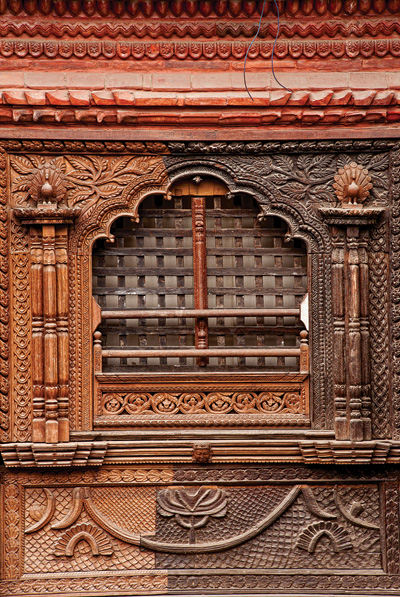 There’s a standard set of clichés used by foreign writers when introducing Nepal, but none is more prominent than the classic guidebook introduction, “Nepal, a land of contrasts where medieval culture persists today.” The phrase has received a lot of mileage, and for good reason. Where else can you witness daily pujas in 400-year old temples? In Europe or the US, a similar building would be roped off and require a ticket for entrance.
There’s a standard set of clichés used by foreign writers when introducing Nepal, but none is more prominent than the classic guidebook introduction, “Nepal, a land of contrasts where medieval culture persists today.” The phrase has received a lot of mileage, and for good reason. Where else can you witness daily pujas in 400-year old temples? In Europe or the US, a similar building would be roped off and require a ticket for entrance.
To people here, the various historical monuments scattered across the Kathmandu Valley are not artifacts. When a wall of an old house crumbles, or a statue in a temple breaks, it needs to be replaced so it can continue to be used. Who would want the task of restoring these ancient buildings and monuments in a place where they are both admired by foreigners while simultaneously used by locals every day?
The man behind the restoration
Meet Dr. Rohit Ranjitkar. Bespectacled and dressed in a neat black sweater with matching dress pants and shoes, the doctor’s appearance doesn’t fit the scene swirling around him at the moment. We are standing in the middle of Bhandarkhal Botanical Gardens behind Mul Chowk, just off of Patan Durbar Square.
The vast courtyard space was once the private garden of kings and queens, but today it’s filled with workers toiling away at their various trades. A group of young men, bare feet caked with mud, are furiously shoveling layers of dirt into the back of a truck, digging down to the original stone floor of the courtyard. Women walk back and forth unloading baskets of bricks into ad hoc piles. The piles are roped off as if they are artifacts themselves, but ancient wooden struts, each carved to depict dragons with rather large penises, rest unguarded against a brick wall. In the background, the buzz of a saw continually hums as artisans carve thick wooden window frames out of raw timber. This is restoration in practice.
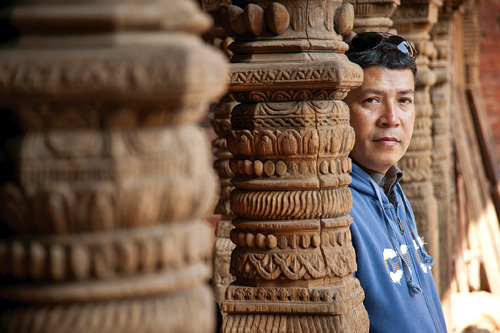 “I like to keep an eye on how things are coming along,” Dr. Ranjitkar says with an encompassing wave of his hand. As the Program Director and Conservation Architect at the Kathmandu Valley Preservation Trust (KVPT), the doctor is in charge of this organized chaos. KVPT has restored temples and buildings all around the valley since 1991, but this particular project was initiated in 2006.
“I like to keep an eye on how things are coming along,” Dr. Ranjitkar says with an encompassing wave of his hand. As the Program Director and Conservation Architect at the Kathmandu Valley Preservation Trust (KVPT), the doctor is in charge of this organized chaos. KVPT has restored temples and buildings all around the valley since 1991, but this particular project was initiated in 2006.
Ranjitkar is currently overseeing the restoration of the garden, as well as Mul Chowk and Sundari Chowk, both courtroom spaces within the palace complex. It’s his job to make these spaces resemble what they looked like a century or more ago. With a Master’s degree and PhD in architecture from Belarus in the former Soviet Union, and decades of experience in the field, Ranjitkar is up to the task, but he’s not without his fair share of obstacles.
“This garden is particularly difficult because we don’t have many photos,” he says. A large amount of KVPT’s restoration work is done based on old photos, Ranjitkar explains. There are hundreds of pictures and paintings documenting the changes in Patan Durbar Square on the other side of the palace complex, but not so many for these inner places.
Today, the space resembles a construction site more than a garden, but three hundred years ago, it was the personal relaxation getaway for the Malla kings of Lalitpur. The centerpiece of the large open space was a stone pond, roughly two meters deep and 15 meters long. Two statues guarded the entrance and a spout continually filled the pond with clean water. Today, the water is green and stagnant, but much of the pond’s stonework has been recovered or rebuilt. The king’s pavilion overlooks the water, and the queen’s changing room is tucked beneath it. Only a very select group of people had access to this space for centuries. Today, people can enter Mul Chowk to view some of the construction, but the gardens are still off limits.
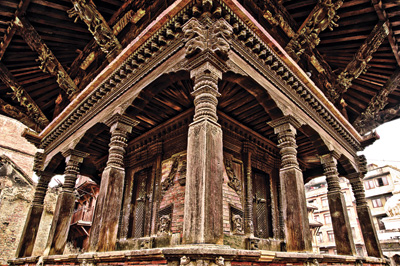
After the invasion and ensuing victory of Prithvi Narayan Shah over the kingdoms of the Kathmandu Valley, the palace at Patan Durbar Square became a sort of administrative center. The Shah king himself set up his own residency in Kathmandu Durbar Square, and the garden saw few visitors. In the aftermath of the earthquake of 1934, debris were piled here until the entire area was covered in four feet of mud and dirt, leaving Dr. Ranjitkar and his crew with little inspiration to work from. The young men shoveling black dirt are removing layers of earth that have been here since the earthquake.
Issues with international standards
Headquartered in New York City, the Kathmandu Valley Preservation Trust was co-founded in 1990 by Architect Eduard F. Sekler, a Professor at Harvard University, and Architect Erich G. Theophile, currently one of KVPT’s executive directors. As the preeminent international nongovernmental agency working in the field of cultural heritage in Nepal, the Trust is at the forefront of most significant restoration work in the country. Over the last 20 years, KVPT has played a role in restoring more than 30 temples and monuments all around the valley. Some of its more famous projects include Babar Mahal Revisited, Garden of Dreams, the Kageshwar Mahadev Temple, the Lakshmi Narayan Temple and the Kal Bharaiv Shrine. A few temples have been completely rebuilt from scratch, but most involve partial reconstruction.

Throughout his time with KVPT, Ranjitkar has run into a conflict of philosophies involving these partial reconstructions. The international norms that dominate the restoration profession clash, at times, with how restoration is organically done in Nepal, and most of these ideas stem from one particular treatise from the mid 20th century.
The 1964 Charter of Venice set international standards for the conservation and restoration of historical monuments, with its focus largely on the ancient relics of Europe. It discourages contemporary additions to historical buildings, but tolerates them if they are thoroughly researched and documented and clearly marked as new and different additions. The charter was tailored to meet the needs of ancient churches and artifacts that had been out of use for centuries, a sharp contrast to the historical buildings of Nepal.
KVPT, which has both international and local staff and donors, set out to restore the 13th century Sulima Temple in the late 1990’s. The temple was largely intact, including many of its pre-Malla period carvings and wood work, but eight of its intricately carved struts had been missing since the 1960’s.
“We had no idea what the struts looked like until we found photos in a book called Nepal Mandala,” Ranjitkar says. The only problem was that out of eight total struts, only six were in the photo. Using what Ranjitkar calls ‘conjectural restoration’, KVPT had all eight struts made and added to the temple. This is permissible under the 1964 Charter, but not encouraged. The locals who still use the temple appreciated the gesture, but to international restoration experts, it would be a faux pas.
“The idea is to preserve something as you found it, rather than adding to it. Western professionals tend to not like it when we rebuild something as it looked, or we think it looked,” he explains, “But the local people don’t want to see two plain struts next to six nicely carved struts.”
There was no fallout for this conjectural restoration, but it does highlight a larger balancing act that Ranjitkar and his colleagues at KVPT constantly face. The 1964 Charter states, “[The process of restoration] must stop where conjecture begins.” However, to restore something historical so that it can be used, not just viewed, can mean wading a little deeper into conjecture.
Authentic artisanship
The buzz of the saws gets louder as we walk to the woodshed near the back of the Botanical Gardens. Four men are busy splitting large planks of wood into more manageable sizes as we approach.
“It took 30 woodcarvers to make this out of three and a half cubic feet of wood,” Ranjitkar says, laying his hand on a thick window frame made of pure sal wood. “There are no nails; it fits together like a puzzle.” The men show us by dismantling the window piece by piece. One of the artisans explains that, when the window is completely finished, it will be jammed into a wall and firmly set in place, just as similar windows have been crafted and jammed into place for centuries.
In many parts of Europe, artisanship is all but extinct. In Nepal, artisanship is not only alive and well; it is a normal way to make a living. The tension between eastern and western restoration philosophies often revolves around authenticity and can be seen in the case of artisans. To add a carving or piece of handicraft to a building in Nepal is to employ the exact same method that was used when the Patan Palace complex was first built. Window frames, wooden carvings and sculptures are made in the same way, with the same tools, by decedents of the same families who made much of the original ornamental features around the palace. To the European, adding a piece or strut to a historical building would be compromising authenticity. Here restoration professionals have the unique opportunity to work with people who use original techniques and supplies. Adding a woodcarving to a temple is just as natural as it was in the 18th century. “For the craftsmen, this isn’t restoration, it’s normal. It’s making a living the only way they know how,” Ranjitkar says.
Yet there is a fear that eventually some of these traditions will die out. Artisans tend to guard their trades ferociously. Ranjitkar says there are some Newari fathers who will only teach their favorite son how to perform their family’s craft. There’s no school for craftsmen. If a generation were to not learn, or somehow forget, the craft would be lost. That’s why many of the people working on the Patan Durbar Square project view their task not as restoration, but as simply continuing tradition.
Lasting effects of the earthquake
As we leave the garden and enter the open space of Mul Chowk, the doctor begins to point at segments of wall that collapsed during the earthquake of 1934. Whole sections have been rebuilt, as evidenced by their lighter colored bricks. Other woodcarvings also seem to be slightly out of place, upon closer examination. They have been brought in from other temples.
The earthquake is a significant year for people in the restoration business. All of the Kathmandu Valley’s historically meaningful buildings had to endure it and each bares its mark in some way or another, and some much worse than others.
Just in front of the KVPT’s office, near the southwest corner of Patan Durbar Square, is a temple that was completely destroyed by the quake. By 1936, Bhaideval temple had been completely rebuilt by locals, but without any regard for the appearance of the previous temple. “It wasn’t built for restoration’s sake, but for utility,” Ranjitkar says of the temple. Simply put, the gods needed a new home, quickly.
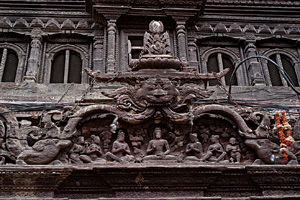
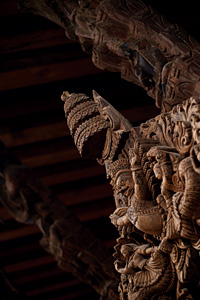 The most efficient way to make this happen was to erect a lime-washed square shaped brick temple. According to a photo of the square from 1920, Bhaideval had previously been one of the largest, most exquisitely designed temples prior to the earthquake. It had three pagoda-style roofs and intricate carvings in every doorway and window frame. Today, the building has no windows and is adorned on top by a large Mughal-style dome roof, a feature that clearly marks it as the architectural black sheep of the temples and monuments around Patan Durbar Square.
The most efficient way to make this happen was to erect a lime-washed square shaped brick temple. According to a photo of the square from 1920, Bhaideval had previously been one of the largest, most exquisitely designed temples prior to the earthquake. It had three pagoda-style roofs and intricate carvings in every doorway and window frame. Today, the building has no windows and is adorned on top by a large Mughal-style dome roof, a feature that clearly marks it as the architectural black sheep of the temples and monuments around Patan Durbar Square.
KVPT has begun plans to restore Bhaideval, but the actual operation will involve complete reconstruction. The venture will be one of the first locally-funded restoration projects in Nepal, with donated funds coming from NIBL bank. There are numerous activists, professionals and locals involved in the project as well, including Kanak Mani Dixit, Satya Mohan Joshi, Prithvi Pande, and Dr. Ranjikar. The restorers will use the 1920 photograph, a watercolor painting from 1853 and the surviving stone foundation of the temple to accurately reconstruct Bhaideval. If all goes according to plan, it should be complete in two years. While the local support for this project is appreciated by Ranjitkar, it’s not the norm.
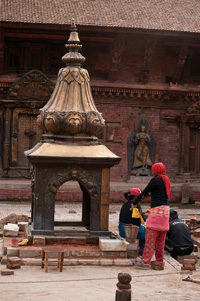 “The people don’t give offerings to architecture or antiquity, but to a god,” he says, “The intention isn’t bad. But we don’t have a hugely romantic view of history here. We are always dreaming of the new. I spend more time convincing people not to dismantle buildings than I do actually restoring buildings.”
“The people don’t give offerings to architecture or antiquity, but to a god,” he says, “The intention isn’t bad. But we don’t have a hugely romantic view of history here. We are always dreaming of the new. I spend more time convincing people not to dismantle buildings than I do actually restoring buildings.”
The fear is that as the population of the Kathmandu Valley continues to explode, the wave of concrete houses will encroach and encompass the historical relics. After all, Dr. Ranjitkar explains, it’s all about money. “When people actually have money, they destroy their house and build a new one. When they don’t, they maintain their house,” Ranjitkar says. The same thing goes for additions to temples. When someone gives a donation to a temple, an upgrade is added, and most of these upgrades don’t bide by the 1964 Charter of Venice. “That’s why you’ll see these old temples with shiny new bath tiles on the floor,’ Ranjitkar says with a chuckle.
People of the Square
Outside of Mul Chowk, Buddhi Raj Bajracharya, 67, and Krishna Sakya, 65, sit on the steps of a temple as evening sets in over the square, just as they’ve done for several decades now. They are both lifelong residents of Patan Durbar Square.
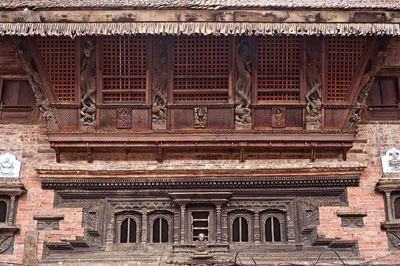 “The only major change I have seen are in the road,” Bajracharya says, “The bricks are organized and laid out now; they weren’t before.” Besides that, he’s noticed numerous small changes - minor replacements of shrines or temple upgrades - but the overall aesthetic is relatively similar. “I remember as a kid, the tourists who came here were treated like gods. We would return their cameras or bags to them if they left them behind,” Sakya says, “That has changed now.”
“The only major change I have seen are in the road,” Bajracharya says, “The bricks are organized and laid out now; they weren’t before.” Besides that, he’s noticed numerous small changes - minor replacements of shrines or temple upgrades - but the overall aesthetic is relatively similar. “I remember as a kid, the tourists who came here were treated like gods. We would return their cameras or bags to them if they left them behind,” Sakya says, “That has changed now.”
Prior to the earthquake and even up to the 1950’s and 60’s, the area around Patan Durbar Square was relatively devoid of the shops that now line the streets. Both Bajracharya and Sakya remember a time when travelers would simply sleep on the temple steps, before waking up the next morning and continuing on their way. The commercialization of the square, and its general upkeep do not necessarily bother either of them.
“I appreciate the people who maintain the temples,” Sakya says, “When something breaks, it’s rebuilt and added. I don’t care if it’s accurate, I just appreciate that the square has been able to look relatively the same for all these years.”
Caught in between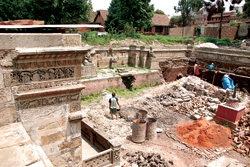
Before leaving, Ranjitkar leads me back inside to the last inner courtyard he is currently working on, Sundari Chowk. The space is smaller than Mul Chowk, but the bath in its center, Tusha Hiti, is the most complex and impressive feature I have seen thus far. 52 intricately carved figures of gods and goddesses line the pool, which was built in 1647. The entrance is guarded by two lions and its perimeter is encircled by two snakes. While the rest of the courtyard is made of brick and wood, the pool is completely comprised of stone.
“This is the most beautiful place in the palace,” Ranjitkar says. This section of the palace is still blocked off from the public, but soon enough it will be open to all. The hope is that foreigners and locals alike will gain a deeper appreciation for Kathmandu’s places of history.
For now, the doctor finds his own philosophies somewhere between the western and Nepali views on antiquity and restoration. To be a practicing restoration professional in Kathmandu is to walk a tight rope between the two.









